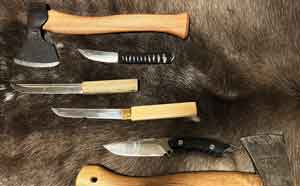Knives used in bushcraft

It explains the cutlery and craft tools used in bushcraft, such as knives, axes, and saws.
overview
Knife-chan is the main tool used for crafting.
The three main tools are a hand axe, a knife, and a saw. Except for tying, you can do almost everything with just this knife, so it's like the life of bushcraft.
Of course, it is also part of bushcraft to investigate differences in usability depending on the sharpening method and shape.
knifeof bushcraft
In bushcraft, it is a versatile knife that can be used for crafting, cooking, picking fruits and edible wild plants, but simple, small and thin ones are preferred over functional ones.
If you're an authentic Nordic bush crafter, the knife called Puukko, which was mentioned above.
Personally, I like Japanese Makiri knives used by Ainu and fishermen.
Also, I like to use knives that are made by folding a Japanese sword and attaching a handle and a scabbard to it.



Of course, you can also use a hunting knife like THE outdoor knife without being bound by the standard.
However, for durability reasons, it may be better to avoid using a holding knife(folding type) or a knife with too thin a blade.
Tristick
Once you buy a knife, learning how to cut with a tri-stick is the first step in bushcraft.
The real pleasure of the tri-stick is not only how to cut, but also the accuracy of sharpening and judging what kind of cutting is easy with that knife.
I'm not very good at brushing, but please read the tri-stick page.
As bushcraft, many people sharpen the file and make their own knives (craft).
Hatchetof bushcraft
The size of the hatchet varies depending on how it is used, and if used for crafting, a smaller one called a hatchet is around 230-240mm.
About 350 to 400 mm for outdoor use when chopping wood.


I think, but it depends on how you use it, so I think a standard 350-400mm ax would be fine.
If you're new to crafting, an ax with a thin blade is easier to swing.
Unlike the dried firewood sold at the campsite, it is hard, so don't think that batoning is fine.
sharpening
Personally, I think the blade is more important than the size. The ax is commonly used to "split wood with its weight and blade width", but it is also used for roughing in crafts, so sharpening it so that it can "cut with a blade" may be unique to bushcraft.
This is quite difficult because it is thick and hard. Beginners shouldn't think of it the same as sharpening a knife?
A whetstone for an ax would be fine, but whetstone for a sickle
sawof bushcraft
Basically, it is often used for cutting fallen trees instead of cutting firewood, so it is recommended to use a slightly longer one than the one used for camping.
That said, if you have a saw that you use at camp, that's enough.
After that, let's determine the mountain to go and the fallen tree to face.
Backsaw
A disassembled backsaw that you can craft yourself.

Perfect for craft beginners, you can use any kind of wood, no need for exaggerated pre-processing or post-processing, simple structure, parts are separated so you won't have to start over even if you make a mistake, etc. An easy item to make.
If you stick to it, however, you can make it a high-end product by thoroughly considering the design of the length and width and the sense of evenness between the left and right sides.
It is possible to use spare blades for jigsaws, but they are much weaker than those for backsaws, so be careful. Buy blades that are sold for backsaws.
Such backsaws are also popular, but in the home of Northern Europe, silky made in Japan is surprisingly popular, so this one is also recommended.
Craft knifeof bushcraft
A small knife for crafting is also a necessity for bushcraft.
You don't have to have it at first, but you definitely want to have it once you start crafting.
A hook knife or carving knife from Scandinavia.
I use a carving knife and chisel because I am attacking with Japanese things.




Drillof bushcraft


I also use a manual drill depending on what I'm crafting.
Used for connecting holes for legs of chairs and tables, and for making holes for joining trees.
The frequency of use is low when you are new to bushcraft, so buy it when you need it for what you want to craft.
There are two types, one with a handle only and a regular drill bit inserted into it, and the other with only a drill that uses a tree branch for the handle.
The size of the drill doesn't matter so much, so either is fine, but if all the fallen trees at your campsite are thin, use a drill bit type and a narrower drill.
